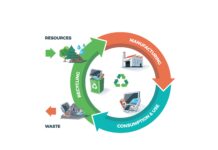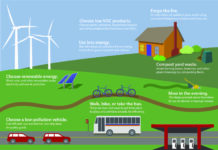
The world is facing a perilous environmental crisis, with climate change, pollution, and resource depletion threatening the very survival of our planet. However, hope lies in the form of innovation, which has the potential to drive environmental change and create a more sustainable future for all. This article delves into the various ways in which innovation is driving environmental change and the opportunities and challenges that lie ahead.
The Environmental Crisis
Climate change is one of the most pressing environmental issues facing the world today. The burning of fossil fuels releases greenhouse gases, such as carbon dioxide and methane, which trap heat in the atmosphere and contribute to global warming. This has led to rising temperatures, melting glaciers, rising sea levels, and more frequent and severe weather events, such as hurricanes, floods, and droughts.
Pollution is also a significant environmental issue, with plastics and other waste materials polluting our oceans and landfills, and air pollution causing respiratory illnesses and other health problems. Resource depletion, including deforestation and overfishing, is also contributing to the environmental crisis by degrading ecosystems and reducing biodiversity.
The Power of Innovation
Despite these challenges, there is hope in the power of innovation. Innovation is about finding new and better ways to do things, and this includes finding new and better ways to live sustainably. From renewable energy technologies to sustainable agriculture practices, there are many opportunities for innovation in the field of environmental sustainability.
The Purpose of the Article
This article aims to explore the various ways in which innovation is driving environmental change and creating a more sustainable future. It will highlight the importance of innovation in sustainability and provide examples of innovative solutions that are already making a difference in the fight against climate change and environmental degradation. The article will also discuss the challenges facing sustainable innovation and the opportunities for future innovation.
Innovation and Sustainability
Innovation and sustainability are closely intertwined, as innovation is essential to creating a more sustainable future. At its core, innovation is about finding new and better ways to do things, and this includes finding new and better ways to live sustainably. Whether it is developing new technologies to reduce carbon emissions, finding new sources of renewable energy, or creating more efficient and sustainable systems of production and consumption, innovation is the key to achieving a sustainable future.
Understanding Innovation
Innovation refers to the process of developing new ideas, products, or processes that create value and solve problems. Innovation can take many forms, including technological innovations, process innovations, and business model innovations.
The Importance of Innovation in Sustainability
Innovation is essential to achieving sustainability. Sustainable development requires finding new and better ways to meet the needs of the present without compromising the ability of future generations to meet their own needs. Innovation is key to achieving this goal, as it allows us to find new and better ways to use resources, reduce waste, and create more efficient and sustainable systems of production and consumption.
How Innovation Can Help to Achieve a Sustainable Future
Innovation can help to achieve a sustainable future in many ways. For example, it can help to reduce our dependence on fossil fuels by developing new and more efficient renewable energy technologies. It can also help to create more sustainable systems of production and consumption by developing more efficient and sustainable supply chains, and by creating more sustainable products and services.
In addition, innovation can help to address environmental issues such as pollution and climate change by developing new and more effective solutions. For example, the development of carbon capture and storage (CCS) technologies can help to reduce greenhouse gas emissions from power plants and other industrial sources. The development of bioplastics made from renewable resources can help to reduce plastic pollution.
Challenges for Sustainable Innovation
Innovation is a key driver of sustainable development, but it also faces significant challenges. One of the biggest challenges is the lack of political will and regulatory support for sustainable innovation. This can make it difficult for innovative solutions to gain traction and for businesses to invest in them.
Another challenge is the lack of investment in sustainable innovation. Many sustainable solutions are not yet commercially viable, and there is often a lack of funding available to support their development. This can make it difficult for innovative solutions to gain traction, as investors and businesses may be hesitant to invest in solutions that are not yet profitable.
Technical and logistical challenges also play a role in sustainable innovation. Many sustainable technologies are still in the early stages of development and need further testing and refinement before they can be scaled up for widespread use. Additionally, creating more sustainable systems of production and consumption may require significant changes to supply chains and logistics, which can be difficult and expensive to implement.
Opportunities for Sustainable Innovation
Despite these challenges, there are many opportunities for sustainable innovation. One promising area is renewable energy, which continues to experience rapid growth and innovation. From solar and wind power to energy storage and electric vehicles, there are many new and innovative solutions emerging in this space.
Another area with significant potential for sustainable innovation is sustainable agriculture. Precision agriculture technologies, sustainable livestock production systems, and agroforestry are just a few examples of innovative solutions that can help to reduce the environmental impact of agriculture and promote sustainable food production.
The circular economy is also an area with significant potential for innovation. Developing new materials that can be easily recycled or reused, creating new business models that prioritize the reuse and repurposing of products and materials, and developing more efficient and sustainable supply chains are just a few examples of the innovative solutions that can help to create a more circular economy.
Examples of Sustainable Innovation
There are already many examples of sustainable innovation making a difference in the fight against climate change and environmental degradation. Here are just a few:
Green Buildings
Green buildings are designed to be energy-efficient, sustainable, and environmentally responsible. They use a variety of technologies and design strategies to reduce energy consumption and minimize environmental impact. Examples include solar panels, green roofs, and energy-efficient heating and cooling systems.
Vertical Farming
Vertical farming is an innovative technology that allows crops to be grown indoors in a highly controlled environment. This technology has the potential to significantly increase food production while reducing the environmental impact of agriculture, as it requires less water and fertilizer than traditional farming methods and can be done without the need for pesticides or other harmful chemicals.
Circular Economy Business Models
Circular economy business models prioritize the reuse and repurposing of products and materials, rather than disposal. Examples include rental and sharing models, such as car sharing and bike sharing, and closed-loop manufacturing systems that minimize waste and maximize resource efficiency.
Sustainable Transportation
Electric vehicles and other sustainable transportation solutions are playing an increasingly important role in reducing carbon emissions from the transportation sector. From electric cars and buses to bike sharing programs and pedestrian-friendly infrastructure, there are many new and innovative solutions emerging in this space.
Conclusion
Innovation is a critical component of sustainable development, but it faces significant challenges. These challenges include the lack of political will and regulatory support, the lack of investment in sustainable innovation, and technical and logistical challenges associated with bringing innovative solutions to market.
Despite these challenges, there are many opportunities for sustainable innovation, from renewable energy and sustainable agriculture to circular economy business models and sustainable transportation solutions. By continuing Certainly, please let me know how I can assist you further.
Google News | Telegram















